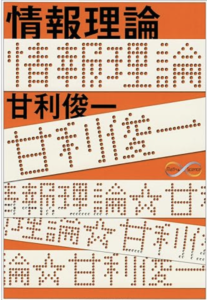Machine Learning Technology. Artificial Intelligence Technology Digital Transformation Technology Natural Language Processing Technology Deep Learning. Information Theory & Computer Engineering Mathematics
From “Information Theory Math & Science.” A Reading Note

It was in 1948 that Claude Shannon published his monumental paper, “A Mathematical Theory of Communication.” More than 60 years later – today, information theory is applied not only to information and communication, but also to a wide range of fields, including the life sciences, brain science, and social sciences. Although information theory uses advanced mathematics, its essence can be clearly seen by understanding the “law of large numbers. From Shannon’s ideas to the fundamentals of information geometry, this book provides a clear explanation that even beginners can understand, and is an introduction by a leading expert to intuitively understand the ideas and mechanisms of information theory.
Chapter 1: Quantitative Recognition of Information
Section 1 Quantity of Information and Entropy
1.1 What defines the quantity of information below
1.2 Entropy
1.3 Entropy of compound events
1.4 Conditional entropy
1.5 Mutual information content
1.6 Chatter
Section 2 Information Sources
2.1 Markov Model of Information Sources
2.2 Markovian Sources of Information
2.3 Redundancy of Information Sources
2.4 Law of Large Numbers for Information Sources
2.5 Ergorticity of Information Sources
2.6 Chit-chat
Chapter 2 Information Transmission over Noiseless Call Routes
Section 1 Noiseless Discrete Call Routes
1.1 Information Transmission Model
1.2 Capacity of Noiseless Discrete Call Channel
1.3 Coding theorem for noise-free discrete calling channel
1.4 Miscellaneous talk
Section 2 Removal of Redundancy by Coding
2.1 Coding and Redundancy Removal
2.2 Coding of simplicity
2.3 Optimal coding method
2.4 Chit-chat
Chapter 3 Information Transmission on Noisy Call Routes
Section 1 Capacity of Discrete Call Routes with Noise
1.1 Information Transmission in Noisy Disturbances
1.2 Call channel capacity
1.3 Error-free information transmission over a noisy call channel
1.4 Chatting
Section 2 Error Correcting Codes
2.1 Error Correction Mechanisms
2.2 Hamming distance
2.3 Hamming code
2.4 Linear codes
2.5 Cyclic codes
2.6 Miscellaneous
Chapter 4 Continuous Information and Signal Space
Section 1 Entropy of continuous signals
1.1 Definition of entropy of continuous signals
1.2 Entropy of various signals
1.3 Conditional entropy and mutual information content
1.4 Signal Transformations and Entropy
1.5 Miscellaneous
Section 2 Composition of Signal Space
2.1 Signal Space
2.2 Sampling Theorem
2.3 Relationship between time-domain and frequency-domain representations
2.4 Chit-chat
Section 3 Continuous Call Routes
3.1 Information Transfer over a Continuous Call Channel
3.2 Capacity of a Call Channel to Generate White Gaussian Noise
3.3 Error-free Communication with Continuous Call Lines
3.4 Chit-chat
Section 4 Information Geometry of Signal Space
4.1 Noise and Metrics in Signal Space
4.2 Riemannian signal space
4.3 Information Theory of Signal Space
4.4 Miscellaneous Talks
Chapter 5 Mapping of Signal Space and Theory of Communication Systems
Section 1 Structure of Communication Systems
1.1 Structure of communication system
1.2 Coding transfer form
1.3 Communication system using continuous mapping
1.4 Quantized communication system
1.5 Miscellaneous
Section 2 Theory of Continuous Communication Systems
2.1 Insertion maps in signal space
2.2 Degenerate maps in signal space
2.3 Change of noise structure in degenerate maps
2.4 Optimal degenerate maps
2.5 Miscellaneous


コメント